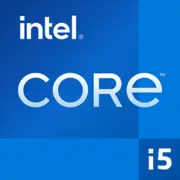Intel Core i5-13490F

Intel Core i5-13490F: A Comprehensive Review of the 2025 Processor
Raptor Lake Architecture, 10 Cores and 16 Threads for $230
Key Features: Power in a Compact Form Factor
The Intel Core i5-13490F processor, released in late 2023, remains relevant in 2025 due to its balanced performance and energy efficiency.
Architecture and Process Technology
- Raptor Lake (13th Generation). An improved version of hybrid architecture: 6 Performance-cores (P-cores) and 4 Efficient-cores (E-cores). The P-cores are responsible for high performance in gaming and demanding tasks, while the E-cores handle background processes.
- 10nm Process Technology (Intel 7). Energy efficiency + high clock speed. The base clock speed of P-cores is 2.5 GHz, with Turbo Boost up to 4.8 GHz.
- 24MB L3 Cache. More than previous i5 models (for example, the i5-12400F has 18MB), which speeds up data processing in games and applications.
Performance
- Geekbench 6: 2644 (single-core) and 13862 (multi-core). For comparison, the Ryzen 5 7600X scores around ~2700/13500.
- Gaming. In Cyberpunk 2077 (1440p, Ultra) with RTX 4070, it delivers a stable 80+ FPS.
- Work Tasks. Rendering in Blender is 20% faster than the i5-12400F.
Key Features:
- PCIe 5.0 support for future graphics cards and NVMe drives.
- Intel Thread Director technology for optimizing core workload.
Compatible Motherboards: How to Choose?
The processor uses the LGA 1700 socket, compatible with 600 and 700 series chipsets.
Recommended Chipsets
1. B760 (Price: $120–160). Optimal choice for most users: supports DDR4/DDR5, PCIe 5.0, reasonable number of USB and SATA ports. Examples: MSI B760 Tomahawk, ASUS TUF Gaming B760.
2. H770 ($150–200). More PCIe and USB 3.2 Gen 2×2 lanes. Suitable for builds with multiple SSDs.
3. Z790 ($200–300). For enthusiasts: RAM overclocking, additional PCIe lanes. Overkill for the i5-13490F, but useful for upgrading to i7/i9.
Important:
- H610 and B660 boards are also compatible but may require a BIOS update.
- Check DDR4/DDR5 support. For example, ASUS Prime B760M-A D4 works only with DDR4.
Memory: DDR4 vs DDR5
The processor supports both types, but with limitations:
- DDR4-3200. Budget option: 32 GB Kingston Fury Beast (2×16 GB) costs $80.
- DDR5-4800. Future-proof solution: 32 GB Corsair Vengeance DDR5 costs $110–130.
Tip:
- For gaming, the difference between DDR4 and DDR5 is minimal (1–5% FPS).
- In rendering tasks, DDR5 speeds up processing by 8–12%.
Power Supply: How Many Watts Do You Need?
With a TDP of 65W, the processor is modest in power consumption, but it's important to consider the graphics card:
- Minimum: 500W (for RTX 4060 or RX 7600 XT).
- Recommended: 650W (for RTX 4070 Ti or RX 7800 XT).
- Certification: 80 Plus Bronze or Gold (Corsair CX650M, EVGA SuperNOVA 650 GT).
Example Build:
- i5-13490F + RTX 4070 + 2 SSDs + 32 GB DDR5 = ~400W under load. A 650W PSU leaves room for upgrades.
Pros and Cons
Pros:
- Ideal for 1080p/1440p gaming.
- Energy efficiency: consumes less power than Ryzen 5 7600X.
- Support for PCIe 5.0 and DDR5.
Cons:
- No integrated graphics (discrete GPU required).
- Ryzen 5 7600X ($250) is faster in single-threaded tasks.
Usage Scenarios
1. Gaming. With RTX 4060 Ti or RX 7700 XT — 100+ FPS in Apex Legends (1440p).
2. Work. 4K video editing in DaVinci Resolve, 3D modeling in SolidWorks.
3. Streaming. NVENC + E-cores offload CPU during broadcasts.
Who is it not for:
- Professionals working with 8K rendering — better to opt for i7-13700K.
Comparison with Competitors
1. Ryzen 5 7600X ($250):
- Pros: Higher IPC, AM5 platform will be supported longer.
- Cons: More expensive, requires DDR5.
2. Core i5-12400F ($160):
- Outdated architecture (Alder Lake), 15% slower in multi-threaded tasks.
Build Tips
1. Cooling. The stock cooler is sufficient, but for quieter operation, consider the DeepCool AK400 ($35).
2. Case. Choose models with ventilation (NZXT H5 Flow, $90).
3. BIOS. Update it before installing the processor (relevant for B660/H610 boards).
Final Conclusion: Who Should Consider the i5-13490F?
This processor is an ideal choice for:
- Gamers looking to play at 1440p without overspending.
- Enthusiasts building a future-proof PC (PCIe 5.0, DDR5).
- Budget workstations for editing and 3D modeling.
At a price of $230, it is one of the best offerings in the mid-range segment. If you don't need integrated graphics and maximum single-threaded speed (as with Ryzen), the i5-13490F is the optimal balance of price and performance.
Basic
CPU Specifications
Memory Specifications
GPU Specifications
Miscellaneous
Benchmarks
Compared to Other CPU
Share in social media
Or Link To Us
<a href="https://cputronic.com/cpu/intel-core-i5-13490f" target="_blank">Intel Core i5-13490F</a>